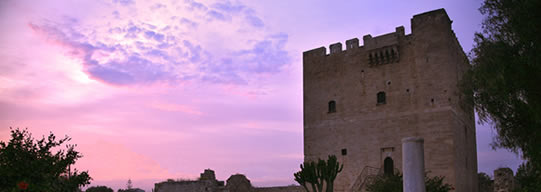
In the heart of the richest valley in the south of Cyprus, western the environs of the city of Limassol, comes up one of the most important forts of the Medieval Cyprus, photo 2, that is the famous Kolossi Castle. This fertile valley to the mouth of the river Kouris was often mentioned by the sightseers of the Middle Ages because of its immense sugar-cane, olive, cotton, locust-tree and cereal plantations as well as its vineyards; it constituted one of the most important feuds of the noble Franks during their dominating Cyprus.
In 1210 Hugues I, the sovereign of the de Lusignans’ dynasty, granted this rich feud to the friars of the Order of Saint John. The name of the area derives most probably from Gerinus de Colos, former feudal lord of the region.
It remains uncertain when the first fortress, of which the ruins round the later monument eastern and western, which escaped destruction, was exactly constructed. The only thing that can safely be mentioned is that it was constructed in the 13th century.
After the fall of Acre (1291), circa 1301/2, the knights of the Order of Saint John transferred the seat οf their activities to Kolossi.
According to the sources, in 1306 Kolossi came under the occupation of the friars’ Order of the Knights Templars, which became a major political force. In 1308 the Knights of the Order of Saint John dominated it again, after Pope Clement issuing the provisions by which the Order of the Knights Templars was declared illegal.
In 1310 the administration seat of the Knights of the Order of Saint John was transferred to Rhodes; however, their already erected fortress in Kolossi remained the seat of Commanderie, the powerful military administration. This regime was confirmed by a relevant decision made by the Order in 1380. The fortress was mostly used as a residence and an administration seat of the leaders of the Order of friars, who organised, controlled and exploited the production of the big plantations in the valley of Kolossi indeed and in the major region, covering initially about 60 villages according to some estimates.
The Commanderie of Kolossi gave its name to the traditional sweet Cypriot wine, which is known until nowadays under the name of commanderie. Obviously, the Order promoted the mass production and marketing of this wine under its name.
In 1373 disastrous raids by the Genoese and in 1402,1413,1425 and 146 by the Mamelukes seemed to leave the initial fortress in ruins.
In 1454 the major commander of the Order, Louis de Magnac B (the blazon in the photograph representing the dynasty of Magnac taken from the great blazon of Kolossi, on which the emblems of the kingdoms of: de Lusignans, Jerusalem, Cyprus and Armenia C in a copy sample are illustrated) had a new and more powerful fortress constructed, the one that still exists today. Photo 3
It is a stone made fortress with walls of a 1.25 m. depth, with three walls of a 21 m. height. The baseground was most probably used as a store with two underground cisterns. One can enter the first floor via a suspended bridge. On the south wall of one of the two big rooms of the baseground there is a wall painting representing the Crucifixion of Jesus Christ and the blazon of Magnac photo 4, which is the testimony of the devotional use of this room while the next room with the fireplace was likely to be the main dining and reception room.
On the second floor there are two more rooms, which were used for lodging. On the roof of the monument, a scalding bowl and loopholes bring the thought of the visitor back to medieval sieges.
In 1488, George Cornaro, brother of Catherine, the last Queen of the Franks, was compensated with obtaining 14 out of 41 villages, which were still under the control of the Commanderie of Rhodes, after persuading his sister to waive her sovereign rights over the island to the benefit of the Venetians, and each Cornaro Family’s leader was granted the title of the High Commander of Cyprus.
This title remained a family distinction even after the Ottomans seizing Cyprus and in 1799 it was granted to the Mozzenigo family, after the marriage of a Mozzenigo with an heir from the Cornaro family.
In the east side of the monument, a big arched room sheltered part of the facilities for the processing of sugar. The Department of Antiquities conducts there an excavation research, on a regular basis over the last five years.



